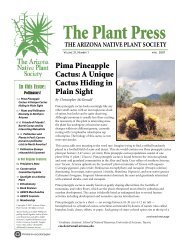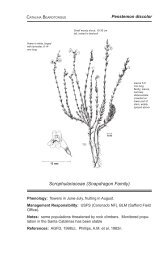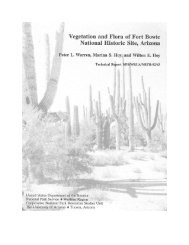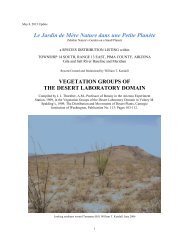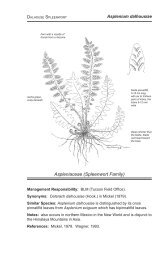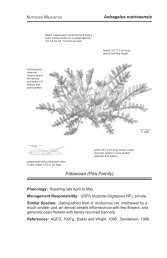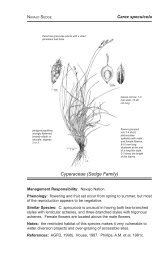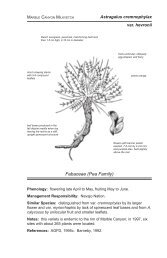T14S.R13E Pima County.AZ 050813 - Arizona Native Plant Society
T14S.R13E Pima County.AZ 050813 - Arizona Native Plant Society
T14S.R13E Pima County.AZ 050813 - Arizona Native Plant Society
Create successful ePaper yourself
Turn your PDF publications into a flip-book with our unique Google optimized e-Paper software.
name also applied to other species); Verdillo (Hispanic); Verdillo Plumerito (Spanish); Zacate de Cinco Dedos; Zacate de Colade Zorra (Hispanic); Woolly-top Rhodes Grass; Zacate Lagunero (Spanish); Zacate Mota (Spanish); Zacate Pluma (Spanish).DESCRIPTION: Terrestrial annual tufted (usually) graminoid (a bunchgrass with decumbent, geniculate, ascending and/or erectculms ½ to 40 inches in height); the foliage is light green curing to light straw; the flowers are greenish; flowering generally takesplace between mid-July and late October (additional flowering records: one for late January, one for early May, three for mid-May, one for mid-November, two for late November; flowering beginning as early as April has been reported). HABITAT:Within the range of this species it has been reported from mountains; rocky and clayey-loamy mesas; bases of cliffs; rockycanyons; gravelly canyon bottoms; ridges; meadows; rocky foothills; amongst hills; rocky hillsides; rocky, rocky-clayey-loamy,gravelly, gravelly-sandy-loamy, gravelly-loamy, sandy, sandy-loamy, loamy and clayey-loamy slopes; gravelly bajadas; amongstboulders, rocks and pebbles; sand dunes; sandy prairies; plains; gravelly, sandy-loamy, loamy and clayey-loamy flats; clayeyvalley floors; valley bottoms; along rocky-gravelly-clayey, gravelly, gravelly-sandy, gravelly-loamy and sandy roadsides;arroyos; sandy bottoms of arroyos; draws; bottoms of draws; seeps; along streams; rocky streambeds; along creeks; creekbeds;along and in rocky, gravelly, sandy and clayey washes; within drainages; within drainage ways; around ponds; ciénegas;freshwater marshes; silty depressions; swales; along banks of rivers; (sandy and sandy-clayey) edges of washes; margins ofwashes; (rocky-sandy) shores of lakes; clayey mudflats; gravel bars; sandy beaches; sandy benches; rocky shoals; terraces; loamybottomlands; floodplains; mesquite bosques; along fencelines; clayey-loamy stock tanks (represos); around reservoirs; alongditches; ditch banks; bouldery-cobbly-sandy and sandy riparian areas; gravelly waste places, and disturbed areas growing inmoist, damp and dry bouldery, bouldery-cobbly-sandy, rocky, rocky-sandy, gravelly, gravelly-sandy, pebbly and sandy ground;rocky-clayey loam, gravelly loam, gravelly-sandy loam, sandy loam, clayey loam, clayey-humusy loam and loam ground; rockyclay, rocky-gravelly clay, sandy clay and clay ground, and silty ground, occurring from sea level to 7,200 feet in elevation in theforest, woodland, scrub, grassland, desertscrub and wetland ecological formations. NOTES: This plant may be an attractivecomponent of a restored native habitat. Chloris virgata is native to south-central and southern North America; Central Americaand coastal islands in the Caribbean Sea; northern, western and southern South America; southern Asia, and Africa and islands inthe West Indian Ocean. *5, 6, 15, 16, 30, 33 (Page 130), 43 (100509), 44 (110211), 46 (Page 126), 57, 58, 63 (110211 - colorpresentation), 68, 77, 85 (110211 - color presentation including habitat), 89 (reported as being a summer annual herb located onthe Santa Cruz Flood-plain, recorded as Chloris elegans H.B.K.), 105, 124 (110211)*Cortaderia selloana (J.A. Schultes & J.H. Schultes) P.F. Ascherson & K.O. Graebner: Uruguayan PampasGrassCOMMON NAMES: Cana-dos-pampas (Portuguese: Brazil); Capim-dos-pampas (Portuguese: Brazil); Capim-penacho(Portuguese: Brazil); Common Pampas Grass; Common Pampas-grass; Common Pampasgrass; Cortadeira (Portuguese: Brazil);Little Pampas Grass; Paina (Portuguese: Brazil); Pampas Grass (a name also applied to the genus Cortaderia); Pampasgras(Afrikaans); Penacho (Portuguese: Brazil); Pluma (Portuguese: Brazil); Selloana Pampas Grass; Selloana Pampas-grass; SilverPampas Grass; Silver Pampasgrass; Silwergras (Afrikaans); True Pampas Grass; True Pampas-grass; True Pampasgrass; UruguayPampas Grass; Uruguayan Pampas Grass; Uruguayan Pampas Grass; Uruguayan Pampas-grass; Uruguayan Pampasgrass; WhitePampas Grass; White Pampas-grass; White Pampasgrass. DESCRIPTION: Terrestrial perennial (evergreen) tufted graminoid (abunchgrass (clumpgrass) with ascending and/or erect culms 40 inches to 20 feet in height and to about the same in width; oneclump was observed and described as being 8 feet in height and 7 feet in width, clumps were observed and described as being 10feet in height and 10 feet in width, two plants were observed and described as being 12 feet in height and 10 feet in width); thefoliage is bluish-green, green or silvery-gray curing to straw; the flowers are lavender, pink or white; based on few recordslocated, flowering generally takes place between late July and mid-October (flowering records: one for mid-March, one for lateJuly, two for early September, three for mid-September, one for early October, three for mid-October, one for mid-December andone for late December). HABITAT: Within the range of this species it has been reported from canyons; loamy canyonsides;canyon bottoms; hillsides; cobbly-sandy slopes; bouldery outcrops; amongst boulders; sandy flats; coastal dunes; coastalsaltmarshes; along roadsides; bottoms of arroyos; gullies; springs; in sandy soils along streams; creeks; rivers; saltwater marshes;along banks of streams; edges of marshes; bouldery floodplains; ditches; riparian areas, and disturbed areas growing in moist anddry bouldery, cobbly-sandy, gravelly and sandy ground and loam ground, occurring from sea level to 6,000 feet in elevation inthe scrub, desertscrub and wetland ecological formations. NOTES: EXOTIC Invasive <strong>Plant</strong> which poses a significant threat toour native biotic communities. Cortaderia selloana is native to central and southern South America. *5, 6, 16, 22 (colorphotograph and note under Giant Reed), 26 (color photograph), 33 (no record of species), 43 (100509), 44 (110211), 63 (110211- color presentation), 77, 85 (110211 - color presentation), 106 (050908), 124 (110211 - no record of species or genus)*Cottea pappophoroides K.S. Kunth: Cotta GrassCOMMON NAME: Cotta Grass. DESCRIPTION: Terrestrial annual or perennial tufted graminoid (ascending and/orerect culms 10 to 40 inches in height); the inflorescence is purple; flowering generally takes place between early September andlate October (flowering records: one for early February, seven for early September, two for late September and three for lateOctober; flowering beginning as early as August and ending as late as November has been reported). HABITAT: Within therange of this species it has been reported from along mountains; cliffs; bases of cliffs; rocky canyons; rocky talus; rocky buttes;ledges; ridges; foothills; hills; hilltops; rocky hillsides; rocky and sandy slopes; sandy bajadas; amongst rocks; sandy and sandyloamyplains; gravelly flats; valley floors; along rocky-sandy roadsides; along and in draws; streambeds; along rocky and sandywashes; within drainages; along (sandy and loamy) banks of arroyos and washes; benches; rocky shelves; terraces; bottomlands;floodplains; mesquite bosques; ditches; riparian areas, and disturbed areas growing in moist and dry rocky, rocky-sandy, gravelly44



